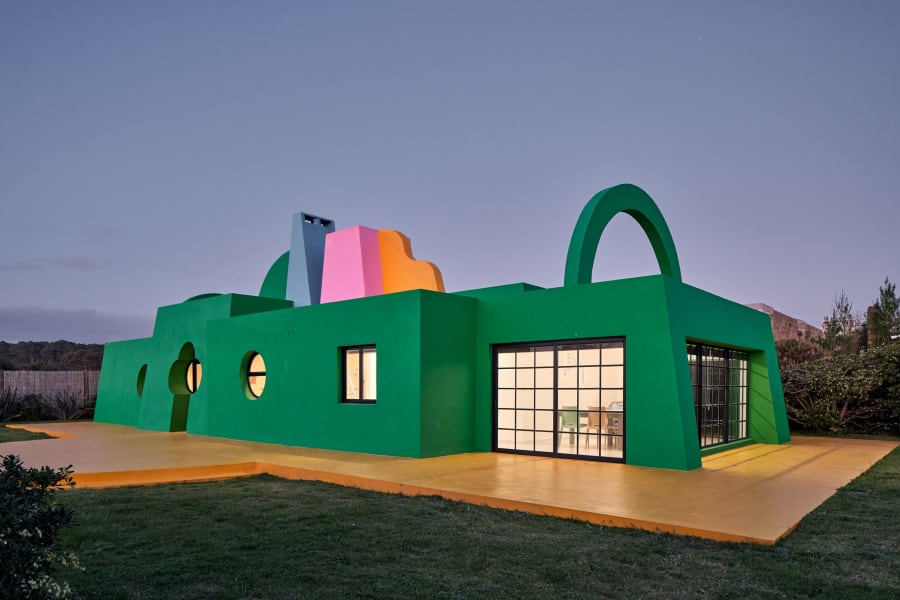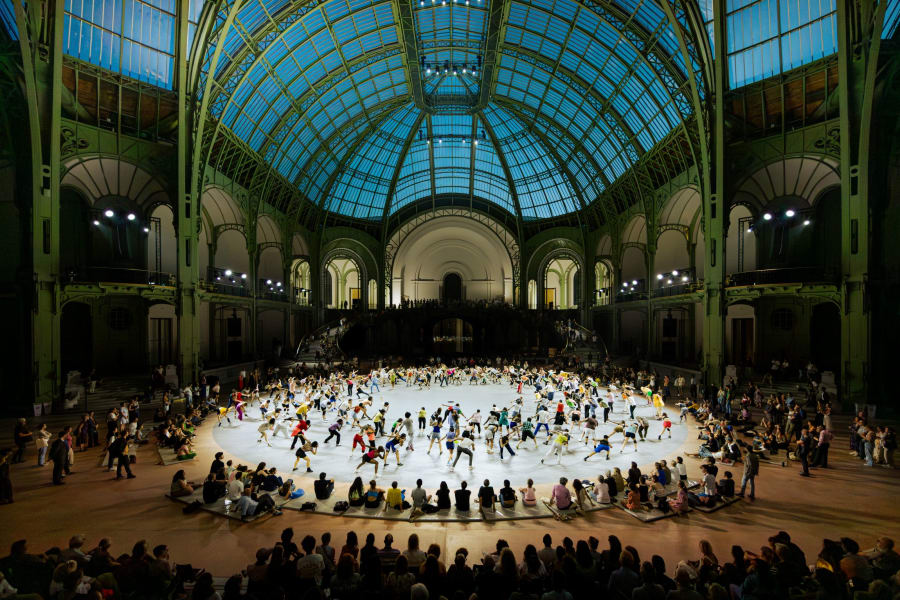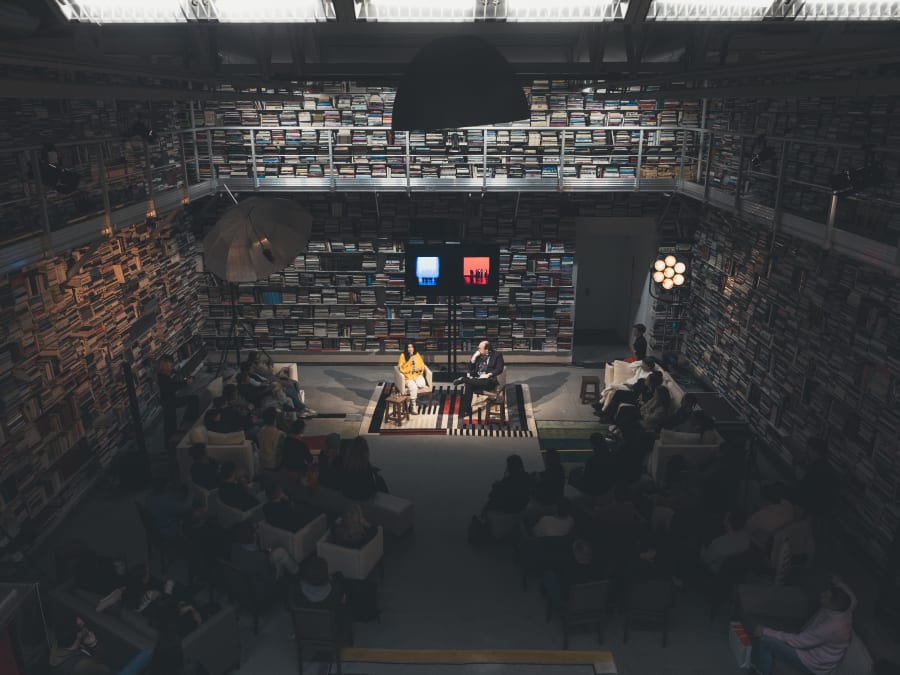大衛.連治(David Lynch)擅長在電影中構建超現實的夢境:無門房間、詭譎光影、揮之不去的不安感。在他2001年的電影《失憶大道》(Mulholland Drive)中,Silencio俱樂部怪誕的歌舞表演,正是介於現實與夢境之間的場景。十年後,真實的Silencio夜店在巴黎第二區開業——其設計正是出自連治之手。
真實的蒙馬特街(rue Montmartre)與電影中狂風肆虐、陰鬱沉悶的停車場大相徑庭,影片中計程車正是在這裡放下兩位主角。巴黎Silencio俱樂部的啞光黑色外牆上,也沒有影片中那種嬰兒藍色「Silencio」草書標誌。實際上,除了門口身著優雅黑襯衫的保安;以及專為深夜必現的排隊人潮而設,用黑絲絨繩圈出的狹窄等候區,再無任何標識表明你已抵達目的地。
從一個僅由沿牆水平延伸的燈條照亮的黑色樓梯頂部進入,一系列夜色般的迷離照片懸掛其上,描繪著奇異景觀:金色隧道、裂地而出的白色樹木,它們被閃電的光芒照得模糊不清。直到你完全走下樓梯,置身於俱樂部之中,方能在連治式自我指涉的巧妙設計中恍然大悟:這些由導演親自拍攝的照片,記錄的正是俱樂部的內部。
首先映入眼簾的是一條金色隧道,牆壁與天花板由粗糙不平的金色木塊構成,質地如同金錠,讓人恍若步入漩渦。俱樂部建在地下六米處,低矮的天花板與無處不在的鏡面設計,巧妙拓展了空間縱深感。連治親自操刀室內裝飾,甚至連傢俱的細微設計都親力親為。燈光設計尤見其風格:地板燈在人們的臉上投下陰影,聚光燈則在走廊上投射出色彩斑駁的光暈,這些光暈逐漸暈染、消散,最終融入一片黑暗之中。俱樂部雖小,卻營造出一種奇妙的居家感——沙龍區陳列著藝術和時尚類的咖啡桌讀物。與此同時,你也能清晰感受到自己彷彿置身於一部荷里活驚悚片的片場。
「連治確實是我們在這個項目上合作的唯一人選,」Silencio聯合創辦人、巴黎夜生活元老人物Arnaud Frisch坦言。Frisch是巴黎標誌性場所Wanderlust以及曾位於Silencio上方的Social Club(現已停業)背後的創意推手。「他無疑是二十世紀最偉大的電影製作人之一,而且體現了我們想要打造的跨學科精神。」
事實上,Silencio遠不止是一家夜店:它是一個融合了文學沙龍與思想交流的複合文化空間。這裡定期舉辦對話、電影放映、展覽及音樂會等文化活動。其所在建築曾是《震旦報》(L'Aurore)印刷廠——埃米爾.左拉(Emile Zola)著名的《我控訴》(J'accuse)正是在此印刷。時至今日,Silencio迎來了Lana Del Rey於2011年完成的巴黎首演,Virgil Abloh的首次DJ演出,Pharrell Williams、Kendrick Lamar、Dua Lipa和Beth Ditto等得音樂會,以及馬丁.帕爾(Martin Parr)的展覽。俱樂部明確致力於促進創意人群的交流與不期而遇。
「這是一個私密的俱樂部,由許多不同的房間組成,」Frisch解釋道,「這種佈局讓人們在走廊和各空間穿行時有更多相遇的機會。你也可能會有點迷失方向——尤其是初次到訪時。」
俱樂部實行會員制,許可權劃分清晰。舞池被血紅色燈光籠罩,狹小空間迅速被湧動的人群填滿。兩側是絲絨繩分割的私密卡座,空間愈發緊湊,只有佩戴特殊手環的會員才能在DJ台後方相對寬敞的區域自由舞動。吧台正前方,幾張米色厚絨扶手椅看似熱情,實則僅對預訂者開放。酒吧服務人員捧著香檳桶穿梭於人群,VIP室則有保安嚴密把守。
尤其在巴黎時裝周與巴塞爾藝術展巴黎展會等重要文化活動期間,Silencio更是人潮湧動。與此同時,其品牌已實現國際化佈局:伊比薩島(Ibiza)的El Silencio、紐約Silencio現已落成,康城電影節與巴塞爾藝術展邁阿密海灘展會期間也推出了快閃店。「Silencio是一個充滿活力的藝術項目,」Frisch表示,「它是串聯起音樂、電影與時尚的紐帶。」團隊正籌劃在歐洲其他城市,乃至東京開設新據點,還計劃推出Silencio品牌酒店。對此,Frisch說道:「創造相遇與聚集的場所,是Silencio的DNA。」
Catherine Bennett是一位常駐巴黎的撰稿人。
頁頂圖片標題:Silencio,照片由Alexandre Guirkinger提供
2025年9月11日發佈。


